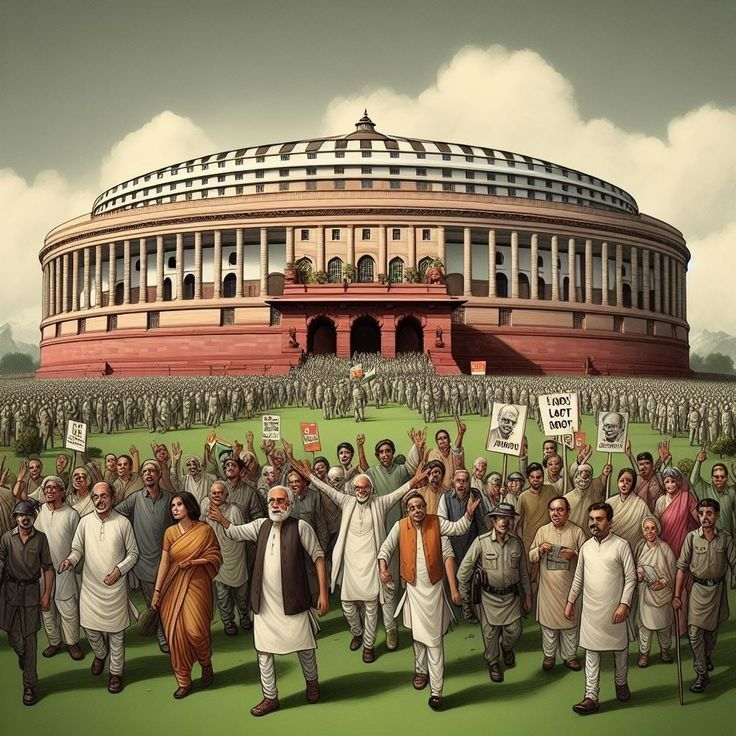Federalism and Division of Powers in India
The Constitution of India establishes a unique system of federal governance with a unitary bias. It distributes powers between the Union and the States to ensure effective administration and avoid conflict in law-making. This division of legislative powers is one of the most significant features of the Indian Constitution, inspired by the Government of India Act, 1935.
The framers of the Constitution designed this scheme to balance national unity with regional autonomy, keeping in mind India’s diversity. The power distribution aims to ensure that both levels of government — Union and State — can function within their respective jurisdictions efficiently. The distribution of legislative powers is primarily contained in Articles 245 to 255 of the Constitution, which outline the scope, extent, and limits of legislative competence.
Thus, the scheme reflects the essence of cooperative federalism, ensuring harmony between central and state governance.
Constitutional Framework: Articles 245–255
The Constitutional scheme for distributing legislative powers between the Union and the States is laid down in Articles 245 to 255 under Chapter I of Part XI.
- Article 245 defines the extent of laws made by Parliament and the State Legislatures. Parliament can make laws for the whole or any part of India, while State Legislatures can make laws for the whole or any part of their respective states.
- Article 246 establishes the principle of distribution by dividing subjects into three lists — the Union List, State List, and Concurrent List — given in the Seventh Schedule.
- Article 247 to 255 further elaborate on specific powers, restrictions, and the resolution of conflicts between Union and State laws.
This system ensures a clear demarcation of authority, while maintaining flexibility to adapt to changing national needs.
The legislative powers are divided both territorially and subject-wise, ensuring that each level of government functions within constitutional limits.
The Three Lists under the Seventh Schedule
The distribution of legislative powers between the Union and States is achieved through the Seventh Schedule, which contains three lists:
(a) Union List – List I (97 Subjects)
This list gives exclusive power to the Parliament to make laws on matters of national importance such as:
- Defence, foreign affairs, atomic energy, banking, communication, currency, and inter-state trade.
- These subjects require uniformity across India.
Example: Parliament alone can legislate on defence of India (Entry 1, Union List).
(b) State List – List II (61 Subjects)
The State Legislatures have exclusive power to make laws on matters of state and local importance, such as:
- Police, public health, agriculture, irrigation, markets, and local government.
However, Parliament can legislate on these matters under certain exceptional circumstances (discussed later).
(c) Concurrent List – List III (52 Subjects)
This list allows both Parliament and State Legislatures to legislate on matters of common interest such as:
- Criminal law, marriage, education, forests, and trade unions.
In case of conflict between Union and State laws on a Concurrent subject, the Union law prevails, as per Article 254.
This threefold division ensures that legislative competence is clearly distributed while allowing cooperation and flexibility.
Principle of Supremacy of Union Law
While India follows a federal structure, it also recognizes the supremacy of Parliament in legislative matters. According to Article 246(1), Parliament has exclusive power to make laws with respect to any of the matters in the Union List, notwithstanding anything in clauses (2) and (3).
Further, Article 254(1) provides that if any provision of a law made by a State Legislature is repugnant to a law made by Parliament on a Concurrent subject, the Union law shall prevail, and the State law shall be void to the extent of repugnancy.
However, under Article 254(2), if the State law has received the President’s assent, it can prevail in that state, though Parliament retains the power to override it later.
This shows that while states enjoy autonomy, Parliament’s legislative authority is paramount when national interests are involved.
Exceptions and Overriding Powers of Parliament
Although legislative subjects are clearly divided, the Constitution allows Parliament to legislate on State List matters in certain exceptional situations:
- During National Emergency (Article 250):
Parliament can legislate on matters in the State List when a Proclamation of Emergency is in operation. - In National Interest (Article 249):
The Rajya Sabha may pass a resolution (by a two-thirds majority) authorizing Parliament to legislate on a State subject in the national interest. - When States Consent (Article 252):
If two or more states consent, Parliament can legislate on a State List matter, and such law can be extended to other states by consent. - To Implement International Agreements (Article 253):
Parliament can make laws on any matter (including State List) to implement international treaties or agreements. - During President’s Rule (Article 356):
Parliament assumes the power of the State Legislature when the state is under President’s Rule.
These exceptions reflect the Constitution’s unitary tilt, ensuring national integrity and administrative efficiency during exceptional situations.
Judicial Interpretation and Landmark Cases
The Supreme Court of India has played a crucial role in interpreting and balancing the legislative powers of the Union and States.
- In State of West Bengal v. Union of India (1963) – The Court upheld Parliament’s supremacy in matters affecting national unity and integrity.
- In State of Rajasthan v. Union of India (1977) – The Court reaffirmed that the Constitution allows Parliament greater power to ensure smooth functioning of the nation.
- In Hoechst Pharmaceuticals Ltd. v. State of Bihar (1983) – The Court clarified that repugnancy arises only when there is an actual conflict between Union and State laws.
Through such decisions, the judiciary ensures that neither level of government exceeds its constitutional boundaries.
Real-Time Example: GST and Cooperative Federalism
The introduction of the Goods and Services Tax (GST) in 2017 is a landmark example of cooperative federalism and legislative power sharing. The 101st Constitutional Amendment Act, 2016 empowered both the Union and the States to levy GST through a Concurrent framework.
This reform required the Union and State Legislatures to coordinate and surrender some of their taxation powers for national economic integration. The GST Council, comprising representatives from both levels, symbolizes a new model of joint decision-making and legislative partnership.
Thus, GST reflects the modern evolution of India’s federal legislative structure, ensuring unity without compromising state participation.
Harmony through Division
The scheme of distribution of legislative powers under the Indian Constitution is a masterpiece of federal engineering. It maintains a balance between national cohesion and state autonomy through a threefold division and specific constitutional safeguards.
While Parliament enjoys predominant legislative power, the states retain autonomy in local governance. The judiciary acts as the guardian of constitutional equilibrium, ensuring that neither the Union nor the States encroach upon the other’s jurisdiction.
In essence, this distribution fosters unity in diversity, strengthens democratic governance, and upholds the principle of constitutional federalism — a hallmark of India’s constitutional design.
Mnemonic to Remember the Scheme of Distribution – “U.S.C.E.J.G.”
Use the mnemonic “U.S.C.E.J.G.” to easily remember the distribution of legislative powers between Union and States:
- U – Union List (List I) – 97 subjects of national importance.
- S – State List (List II) – 61 subjects of state and local significance.
- C – Concurrent List (List III) – 52 subjects shared by both.
- E – Exceptions (Articles 249–253) – Parliament’s power in special situations.
- J – Judicial Interpretation – Ensures balance via landmark cases.
- G – GST Example – Modern model of cooperative federalism.
Mnemonic Meaning: “U.S.C.E.J.G.” reminds that Union, State, and Concurrent powers coexist harmoniously under constitutional checks, ensuring both efficiency and federal unity.
About lawgnan
Explore the division of powers in India and understand how the Constitution balances federalism and unity at Lawgnan.in. Learn about Articles 245–255, the Union, State, and Concurrent Lists, and the role of the Seventh Schedule in distributing legislative authority. Discover how judicial interpretation and cases like State of West Bengal v. Union of India ensure constitutional harmony. Understand the unitary tilt, exceptions under Articles 249–253, and how GST reflects cooperative federalism. This detailed guide is essential for law students and UPSC aspirants studying Indian Polity and Constitutional Law. Visit Lawgnan for expert insights today!



